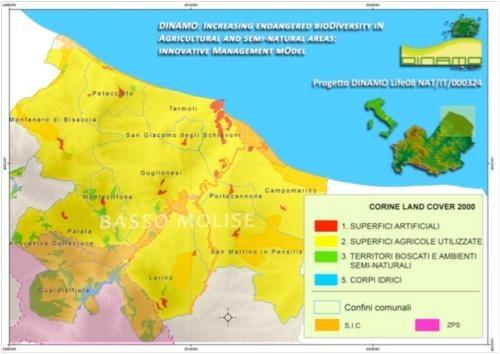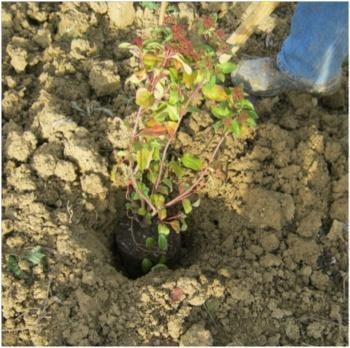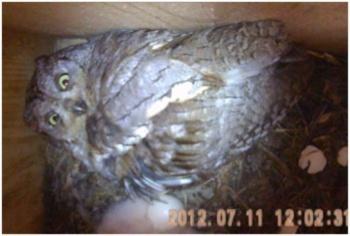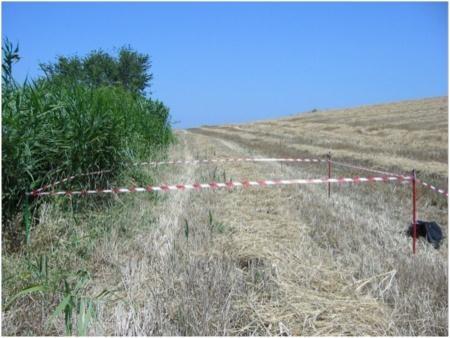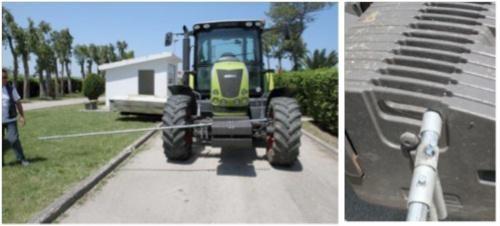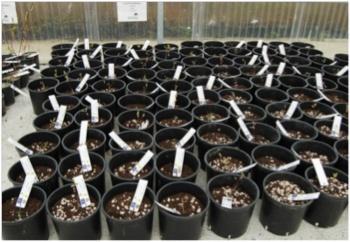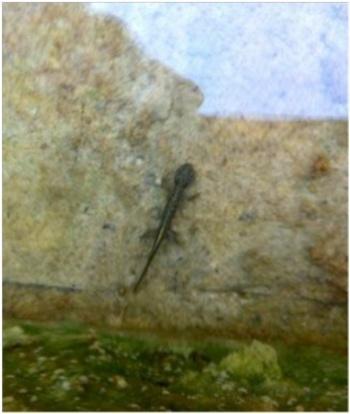The LIFE+ DINAMO project: a model of social participation for the conservation and increase of biodiversity in agricultural areas
On December 31st, 2012, the DINAMO project came to an end. It is an integrated LIFE+ project, which lasted three years and developed a participatory model aimed at conserving and increasing biodiversity at risk of extinction in the agricultural areas of the “Basso Molise” area. The DINAMO project (LIFE08 NAT/IT/000324) saw the participation of the University of Molise as project coordinator, ENEA, CIA Molise, IGEAM DD Srl company as partners, four municipalities of “Basso Molise” and 17 farmers. The project's objectives were the involvement of farmers in the conservation of local biodiversity through income-supporting measures and the implementation of direct conservation actions on biodiversity through practical demonstration in agricultural and semi-natural areas
Il progetto LIFE+ DINAMO: un modello per la conservazione e l’incremento della biodiversità nelle aree agricole attraverso la partecipazione sociale
Il 31 dicembre 2012 si è concluso DINAMO, un progetto integrato LIFE+ di durata triennale che ha messo a punto un modello di partecipazione volto alla conservazione e all’incremento della biodiversità in pericolo di estinzione nelle aree agricole del Basso Molise. Il Progetto DINAMO (LIFE08 NAT/IT/000324) ha visto coinvolti l’Università del Molise in veste di coordinatore, l’ENEA, la CIA Molise, la società IGEAM DD srl in qualità di partner, quattro Comuni del Basso Molise e 17 imprenditori agricoli. Gli obiettivi del progetto sono stati il coinvolgimento degli imprenditori agricoli nella conservazione della biodiversità locale mediante forme di sostegno al reddito e la realizzazione di azioni dirette di conservazione della biodiversità, attraverso pratiche dimostrative in aree agricole e semi-naturali
DOI: 10.12910/EAI2013-09
Paola Carrabba, Barbara Di Giovanni, Massimiliano De Mei, Loretta Bacchetta, Laura Maria Padovani
Introduction
The DINAMO project (LIFE08 NAT/IT/000324) –the English acronym of the title “Enhancement of biodiversity at risk of extinction in the agricultural areas and habitats: an innovative model of management”– was funded in 2008 by the European Commission through the LIFE+ Programme. The triennal (01/2010-12/2012) demonstrative project was coordinated by the STAT Department of the University of Molise, in partnership with ENEA, the Italian Farmers Confederation of Molise and IGEAM DD srl. The DINAMO model is based on the ecosystem approach principles (UNEP, 2000), a strategy for the conservation and sustainable use of biodiversity in a fair and equitable way (Padovani et al., 2003) and it fits into the European Union Strategy for Biodiversity. Such a Strategy aims “to develop, in co-operation with Member States, instruments to enhance the conservation and sustainable use of biodiversity across the territory outside protected areas” (EC, COM (1998) 42 final).
The project also answers the objectives of the European Action Plan “Halting the loss of biodiversity by 2010 - and beyond - Sustaining ecosystem services for human well-being” (EC, COM (2006) 216 final), namely: safeguarding the EU's most important habitats and species (Objective 1), conserving and restoring biodiversity and ecosystem services in the wider EU countryside (Objective 2), reinforcing the compatibility of regional and territorial development with biodiversity in the EU (objective 4).
Also the European Environment Agency (EEA) recently took an interest in the connections among biodiversity, agriculture and ecosystem services in Europe, defining the boundaries within which the DINAMO project operates (EEA, 2010). In addition, with the presentation of the Communication entitled “The CAP towards 2020: Meeting the food, natural resources and territorial challenges of the future” (EC, COM (2010) 672/5), the European Commission highlighted the importance to promote the support to farmers, who take an active part in environmental protection. Despite the importance of the ecosystem services provided by biodiversity (MEA, 2005) it is, however, necessary to locally identify the conservation options more compatible with the sustainable production of goods and services (food, timber, water resources and fisheries, forest products non-wood products, tourism), in order not to create any economic harm to local entrepreneurs. Such a damage, in fact, would ultimately frustrate the efforts for restoration and conservation of biodiversity. Only the outlook for potential economic benefits, in fact, can convince entrepreneurs to pursue the suggested conservation actions over time. Starting from this premises and from the ascertainment that the agricultural areas in Europe represent an environmental widespread matrix, the DINAMO project proposed the implementation of a series of more environmentally sustainable agricultural practices, in order to get a relapse in terms of conservation biodiversity, increase in ecosystem services (Kettunen et al., 2007) and maintenance and/or enhancement of landscape connectivity (Donald & Evans, 2006).
A description of the project area
The implementation area of the DINAMO model includes 10 municipalities of the “Basso Molise”, in the Province of Campobasso. The territory is plenty of zones with high naturalistic value (there are 12 Natura 2000 network sites) and has a strong rural connotation ( 95% of the territory). Public and private sites were selected in this area (adjacent to the Sites of Community Importance – SCI – and the Special Protection Areas - SPAs) in order to carry out a series of direct and indirect actions, aimed at conserving local biodiversity.
The Basso Molise area has a good hydrographic system, which includes the lower course of Trigno and Biferno rivers and Mergola, Tecchio and Sinarca streams, with a humid sub-Mediterranean climate and altitudes ranging between 0 and 400 m above the sea level. The main land uses are related to agriculture in the inland areas (98% of the territory) and artificial areas (buildings and infrastructures), 0.2% of the land being in the coastal area, while natural areas cover approximately 1.5% of the territory. Tourism and industry characterize only specific sites along the coast and some areas of the Biferno River’s valley. Farm production is mainly targeted at irrigated and tree crops. Most farms are medium-sized and directly managed by the owners, who use intensive-farming methods, with a strong specialization in monoculture and with a widespread crop irrigation and mechanization. This often implies an overexploitation of the soil and extensive use of chemicals (fertilizers, pesticides, fungicides, etc.).
By analyzing the land cover according to the CORINE method, it is clear that only 2.3% of the project area is characterized by forests and semi-natural areas. The potential vegetation is represented by oak forests (Quercus pubescens), but the actual distribution of this type of forest is reduced to small relict patches in marginal areas, where intensive farming cannot be practiced.
30% of semi-natural areas is represented by scrubs (3.2.2.) and areas with sclerophyll vegetation (3.2.3.). Small areas are also covered by relict forests of holm oak trees (Quercus ilex) (3.1.1.1.) and woods with a prevalence of hygrophilous species (3.1.1.6). On the coastal dunes there are important areas covered by forests, mostly Mediterranean pines (3.1.2.1).
Twenty habitats of interest were identified along the coast, including 344 species of vascular plants –40 of which are in the regional red lists, considered at risk of extinction due to anthropic stress– and 30 are exotic species, therefore alien to the local native flora (Izzi et al. 2007a, 2007b; Stanisci et al., 2007).
A small strip of mixed oak dominated by the Turkey oak (Quercus cerris) at Le Fantine (Habitat 91M0) has to be highlighted as the only evidence of the forests that once inhabited the sub-coastal territories. For these reasons, as part of the LIFE+ DINAMO project, the 91M0 and 91F0 were taken among the target habitats.
Along some stretches of stream banks there are still some interesting riparian forests of white willow (Salix alba) and white poplar (Populus alba) (Habitat 92A0), which give rise to ecological corridors useful for the dispersion of local wildlife species. The DINAMO project conservation actions, therefore, are also aimed at the expansion of this type of habitat. The coastal plains are surrounded by hills with a more widespread environment, consisting of thorn bushes (Paliurus plug-christi), broom (Spartium junceum), and groves of oak (Quercus pubescens, Q. dalechampii). In these areas there are, among others, strips of habitat 91AA* (woods with Quercus pubescens), which are also target of the LIFE+ DINAMO project.
From the wildlife point of view, the area is home to many vertebrate species, endemic or threatened in the Italian peninsula, which are characteristic to the plains, shrubs, forest and freshwater habitats. Among these, there are endemic amphibians such as the Apennine yellow-bellied toad (Bombina pachypus) and the Italian Crested Newt (Triturus carnifex); threatened reptiles such as the European pond turtle (Emys orbicularis) and the Hermann tortoise (Testudo hermanni); many breeding birds mentioned in Annex 1 of the Habitats Directive, including raptors such as Red Kite (Milvus milvus) and the Long-eared Owl (Asio otus), the Jay (Coracias garrulus) and several larks, including the Calandra (Melanocorypha Calandra), the Calandro (Anthus campestris) and Calandrella (Calandrella brachydactyla). A more detailed description of the project area from a scientific and socio-economic point of view can be found in Carrabba et al. eds. (2011).
The University of Molise has developed a Decision Support System (DSS) that, drawing on a database specifically designed for the project needs, has allowed to better identify the areas where practical conservation actions can be carried out (Carranza, Ciccorelli, 2011). A Web-based GIS is also available online (see web page https://lifedinamo.sf.altran.it/pmapper/map_default.phtml), which provides easier access to the DSS information.
Material and methods
Four municipalities and 17 farmers have been identified and have joined the project, thanks to the Italian Confederation of Farmers (CIA) and their interest to be actively involved in the achievement of practical conservation actions.
Farmers’ involvement was encouraged by the opportunity to combine environmental conservation with potential increase in the income arising, in the case of this project, from direct remunerations for the implementation of practical conservation actions (European Community Biodiversity Strategy - COM (1998) 42 final). During the course of the project, the possibility to start economic initiatives directly related to conservation activities (e.g., the creation of a brand, launching a zero-kilometer market strategy, etc.) also emerged, in order to facilitate the monitoring of actions beyond the end of the project.
The above mentioned objectives were pursued through the establishment and operation of two participatory tools, one for discussion and decision-making processes, and the other for implementation. The first instrument, the Agriforum, is a moment of participation, sharing and dissemination of information on the project activities.
The second instrument, the Action Network, enabled to actually carry out the conservation actions decided in the Agriforum. At the six Agriforum meetings carried out during the three-year project, there has been the participation of the partners, farmers, Public Administration, municipalities, local associations, individuals and all the people who, for various reasons, have shown interest in the management of the territory. The activities carried out, the arising difficulties and the results achieved have been discussed during the Agriforum, future engagements have been planned and the different strategies to support the DINAMO activities after the end of the project have been taken into account.
The Action Network is the operational arm of the DINAMO Model. It is made of farmers who participate in the model and made themselves available to implement the practical actions scheduled in the project within their companies and in the public areas provided by the municipalities.
The Action Network is also a way to give a “mutual” sense to the activities designed and implemented by all farmers for their land. No longer just companies but production companies united under the umbrella of the DINAMO project and the European Programme LIFE+ logo, therefore more recognizable at the local, national and international levels. This last statement is supported by the fact that the Common Agricultural Policy, which is currently being developed, is having a greater recognition in terms of financial support to project initiatives proposed by companies that concretely demonstrate to pay special attention to the environment. Therefore, the participation in the DINAMO Model is actually an advantage for the farms involved.
Within the three-year project, the DINAMO Action Network implemented a series of practical actions for biodiversity conservation, aimed at increasing the populations of species and habitats at risk of extinction in Europe, therefore protected by the Habitats Directive 92/43/EC:
- increasing the reproductive capability of five species of breeding birds, typical of coastal open areas: the European Roller (Coracias garrulus), the Red Kite (Milvus Milvus), the Calandra (Melanocorypha calandra), the Calandro (Anthus campestris), and the Calandrella (Calandrella brachydactyla);
- restoring springs for the recovery of the two Italian species of endemic amphibians’ habitats: the Ululone Apennines (Bombina pachypus) and the Italian Crested Newt (Triturus carnifex);
- recovering natural vegetation and habitats of Community interest in marginal areas: Habitat 91M0 - Pannonian-Balkan Forests of oak, riparian forests; Habitat 92A0 - Galleries in Salix alba and Populus alba; Habitat 91F0 - Riparian forests of Quercus robur, Ulmus laevis and Ulmus minor, Fraxinus excelsior or Fraxinus angustifolia, Habitat-91AA * Eastern Woodlands of white Oak (Quercus pubescens).
The protection and restoration of these habitats are also functional to the creation of corridors and restoration of habitats for other species of fauna of community interest, such as the European aquatic turtle (Emys orbicularis), the Herman's Tortoise (Testudo hermanni), the Long-eared Owl (Asio otus) and the hobby (Falco subbuteo) (Loy et al., 2010).
Project results
The project terminated at the end of December 2012. Therefore, the results achieved in terms of practical actions, people and institutions involved, as well as the effectiveness of the proposed model are already partially evaluated. As far as actions conservation practices are concerned, 10 artificial nests for the Red Kites (Milvus Milvus) and 120 artificial nests for the European Roller (Coracias garrulus) have been prepared, installed and monitored. Monitoring performed at the end of the 2012 breeding season did not allow to detect the use of nests by the target species, while the occupation by other species is an encouraging sign for future breeding seasons. A nest of Red Kite has been occupied by a pair of black kites. Out of a total of 121 nests, 50 (41%) were used by different species.
Of these, 62% were occupied by birds, while 20% were used by mammals (Gliridi hibernating), and 12% by insects (especially beetles and ants). Such high values of occupation of artificial nests can be reached only after 3-4 years after installation (Aviles et al., 2000), while in this case they have been achieved only one year after installation.
This result was particularly encouraging, also in consideration of the fact that the Coracia garrulous tends to occupy nest boxes already used in recent years by other species, e.g. owl and kestrel (Aviles et al., 2001). Five fledging bars have been designed and installed on tractors operating in the hay meadows on an area of about 141 ha, to protect the chicks and young specimens of the Alaudidi Calandra (Melanocorypha calandra), Calandro (Anthus campestris) and the Calandrella (Calandrella brachydactyla).
To increase the availability of suitable breeding habitats for the Ululone Apennines (Bombina pachypus) and the Italian Crested Newt (Triturus carnifex), three abandoned drinking troughs have been restored, including the repairing, where necessary, of water pipes, the implementation of access ramps to facilitate the accessibility for amphibians, and the creation of additional ecological niches in the surrounding environments (a small drinking trough in “Fonte di Nallo” area). The three restored drinking troughs examined in the Spring of 2011 revealed the colonization of pools and ponds by some specimens of anuran amphibians (frogs and green toads). In August, 2012, a larva of Italian Crested Newt (the target species of the project) was found in the drinking trough of Nallo, proving the effectiveness of the environmental restoration.
Along the ditches and banks of streams Mergola and Tecchio, in the Petacciato municipality, 7500 specimens of 40 species of native trees and shrubs have been planted in 3 acres, and forest habitats 91F0 and 91M0 have been restored in 5 acres of state and municipal areas, through the planting of trees (about 1900) and shrubs (about 5700) belonging to the potential native vegetation in the areas.
Interventions made in the public system were, unfortunately, subject to an arson in June 2012. The fire affected most of the surface of the plant (about 90%). A survey carried out in October 2012, however, showed 40% of recovery rate of the plants. The passage of fire did not significantly altered the floristic-vegetation composition of the plots. A total area of 7.39 acres and 1059 meters, distributed along streams and ditches, along the shores of lakes within 7 farms was regenerated in order to increase biodiversity in the agro-ecosystems and the connections with the Natura 2000 network’s neighboring areas. The re-naturalization of these unproductive areas, especially those already occupied by thickets and bushes, is proceeding with the increase in coverage of different shrub species and the entry of other nemoral plant species. In particular, the recovery of vegetation proceeds with greater speed in the once bushy or arboreal areas extending along the shared limits, with recovery times of native woody vegetation that can be estimated (from multi-temporal analysis conducted in the area of the landscape ) in 10-15 years, in the absence of human disturbance.
With regard to target species’ seeds and cuttings, they have been collected, cleaned and stored at the Germplasm Bank of Molise, by acquiring 4200 plants and 8100 seeds of 34 tree- and shrub-native species for their propagation and use in reforesting public areas. Their “ex-situ” conservation makes local ecotypes of native woody species available, even after the end of the project, and start a synergy with the Regional Forestry Centers and Nurseries.
For more detailed information on the scientific aspects of the project implementation, please read: http://www.life-dinamo.it/
However, the most important result achieved by the project relates to the local participation. The farms directly involved that have actively contributed to the project are 17, but other companies have already expressed their interest to engage in the activities that may arise in the near future. The inspiration provided by the DINAMO model nurtured in farmers a natural planning skill, aimed at enhancing the work already accomplished through the establishment of an association. Furthermore, also thanks to a corporate brand, the conservation activities implemented in the private and public areas of the project and the company's commitment to protect local biodiversity have been emphasized.
The brand will therefore support the sales of the products of those farms that agree to keep implementing the conservation actions even after the formal conclusion of the project. The project activities have also generated significant synergies with other local realities interested in the conservation and management of biodiversity, as well as some non-profit organizations, the Germplasm Bank of Molise, some local forest nurseries, and other local municipalities. The work of networking at local, national and international levels was carried out by the project partners also thanks to the creation of a dedicated website (http://www.life-dinamo.it/) and a regular newsletter.
Conclusions
A greater awareness of the value of the natural environment, combined with the ability to implement multifunctional practices, may be the keystone of a change in the farmers’ role in biodiversity conservation and in the defense of agricultural land in Europe. The DINAMO project experience demonstrates how to combine these aspects of biodiversity conservation with a fair increase in the agricultural income through appropriate participation activities at the local level.
References
Avilés J.M., Sánchez J.M., Parejo D., 2000. Nest-site selection and breeding success in the Roller (Coracias garrulus) in the Southwest of the Iberian peninsula. Journal fur Ornithologie, 141 (3): 345-350.
Avilés, J.M., Sánchez, J.M., Parejo, D., 2001. Nest-boxes used by Eurasian kestrels Falco tinnunculus are preferred by rollers Coracias garrulous. Folia Zoologica, 50 (4):317-320.
Carrabba P., Padovani L.M, De Mei M., Stanisci A., Carranza M.L. (eds.), 2011. Il Progetto DINAMO per la biodiversità del Molise (LIFE08 NAT/IT/000324). D.1.S – D.2.S – D.3.S. ENEA. Roma. ISBN 978-88-8286-237-4.
Carranza M.L., Ciccorelli G., 2011. Il SITI DINAMO: Un sistema Informativo Territoriale Integrato per la conservazione della biodiversità minacciata nei sistemi agricoli del Basso Molise. In: Carrabba et al. (eds.) 2011 Il Progetto DINAMO per la biodiversità del Molise (LIFE08 NAT/IT/000324) D.1.S – D.2.S – D.3.S. ENEA. Roma. ISBN 978-88-8286-237-4. pp: 35-39.
Commission of the European Communities, 1998. European Community Biodiversity Strategy. COM(1998) 42 final. Brussels.
Commission of the European Communities, 2006. Halting the loss of Biodiversity by 2010 – and beyond. Sustaining ecosystem services for human well-being. COM(2006) 216 final. Brussels.
Commission of the European Communities, 2010. La PAC verso il 2020: rispondere alle future sfide dell'alimentazione, delle risorse naturali e del territorio. COM(2010) 672/5. Brussels.
Donald, P.F., Evans, A.D., 2006. Habitat connectivity and matrix restoration: the wider implications of agri-environment schemes. Journal of Applied Ecology, 43: 209-218.
European Environment Agency, 2010. 10 messages for 2010. Agricultural ecosystems. EEA. Copenhagen.
Izzi C. F., Acosta A., Carranza M. L, Carboni M, Ciaschetti G., Conti F., Del Vecchio S., Di Martino L., Frattaroli A., Pirone G. & Stanisci A., 2007a. Entità a rischio negli ambienti dunali costieri di alcune regioni dell’Italia centrale. Fitosociologia, 44 (2): 251-254.
Izzi C. F., Acosta A., Carranza M. L., Ciaschetti G., Di Martino L., D’Orazio G., Frattaroli A., Pirone G. & Stanisci A., 2007b. Il censimento della flora vascolare degli ambienti dunali costieri dell’Italia centrale. Fitosociologia, 44(1): 129-137.
Kettunen, M, Terry, A., Tucker, G. & Jones A. 2007. Guidance on the maintenance of landscape features of major importance for wild flora and fauna – Guidance on the implementation of Article 3 of the Birds Directive (79/409/EEC) and Article 10 of the Habitat Directive (92/43/EEC). Institute for European Environmental Policy (IEEP), Brussels, 114 pp. & Annexes
Loy A., Carranza M. L., Ciccorelli G., De Lisio L., Iannotta F., Marino D., Ottaviano M., Pelino G., Stanisci A., 2010. DINAMO D.6.S. – 2 Rapporto sul Monitoraggio Scientifico.
Millennium Ecosystem Assessment, 2005. Ecosystems and Human Well-being: Biodiversity Synthesis. World Resources Institute, Washington, DC.
Padovani L., P. Carrabba & F. Mauro, 2003. L’approccio ecosistemico: una proposta innovativa per la gestione della biodiversità e del territorio. Energia, Ambiente e Innovazione. Anno 49-1/2003:23-32.
Stanisci A., Acosta A., Carranza M.L., Feola S., Giuliano M., 2007. Gli habitat di interesse comunitario sul litorale molisano e il loro valore naturalistico su base floristica. Fitosociologia, 44 (2): 171-175.
UNEP, 2000. Decision adopted by the Conference of the Parties to the Convention on Biological Diversity at its fifth Meeting. Nairobi, 2000. UNEP/CBD/COP/5/23, pp. 103-109.


